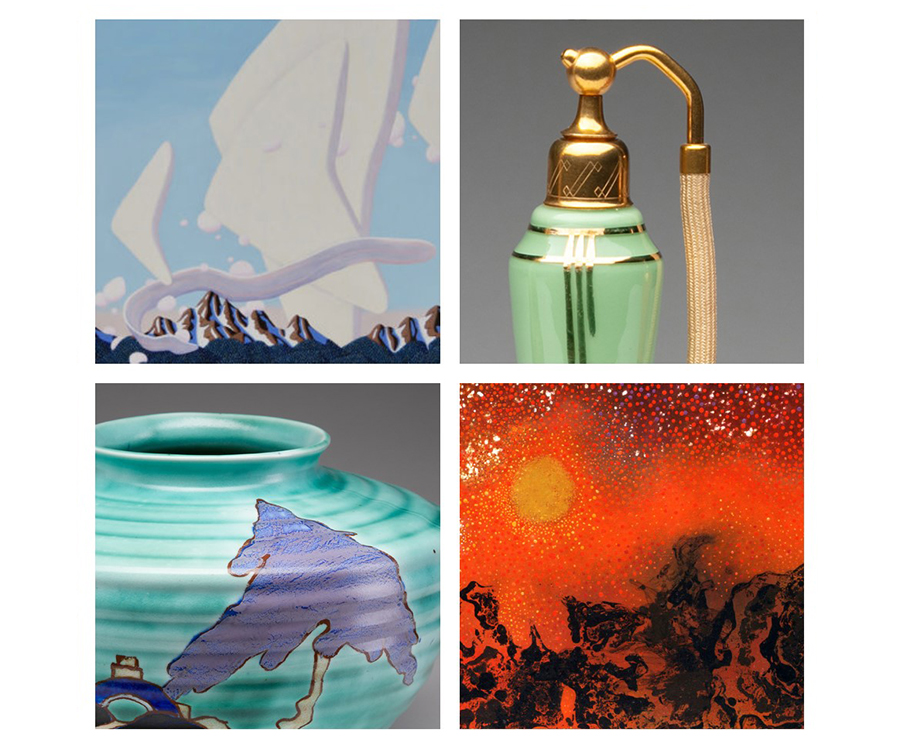VIRTUAL EXHIBITION
Have you ever wondered which artworks the staff at Kirkland Museum like best? Satisfy your curiosity below!
Seek & Find Activity
In conjunction with our Staff Favorites virtual exhibition, participate in a self-guided scavenger hunt to find each of the staff’s favorite artworks on view at the Museum when you are able to visit in person, or take a guess from home!
CAUTION: Viewing the virtual exhibition will provide spoilers for the Seek and Find activity.
Staff Favorites
With about 4,400 works on display, it’s very hard to choose a favorite! That’s something those of us lucky enough to work at Kirkland Museum love about our jobs. Our favorite favorite might change day-to-day; below we present to you our favorites on the day we were asked for this exhibition. We hope our offerings help you look a little more closely at these pieces the next time you visit, and spark your own hunt for beauty in your surroundings. Read why we love the selected work in our own words below.
Leanne’s Favorite: Greene & Greene Bench
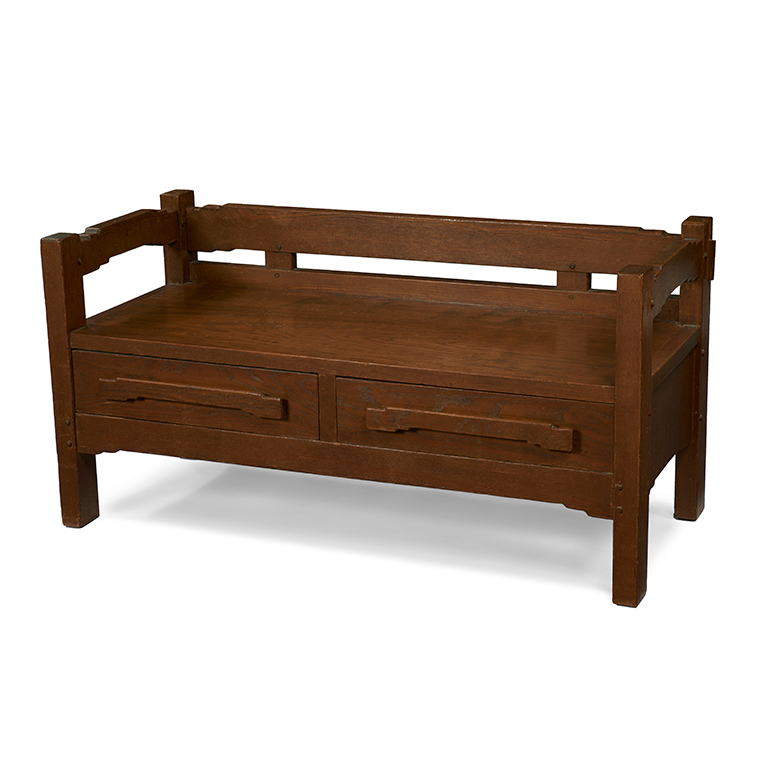
c. 1904–1905
manufactured by
Greene & Greene, Pasadena, CA (1894–1922)
ash wood
22 1/2 x 45 x 20 inches
This piece is Arts & Crafts.
On view in Promenade Gallery 2.
I’m sharing the bench Charles and Henry Greene designed for Mrs. Adelaide A. Tichenor. Apparently Mrs. Tichenor asked architects Greene & Greene to employ a Japanese influence throughout the design for her house; they did and this bench was part of the result. They also enlisted a Japanese aesthetic in much of their later furniture design.
Learning this in the galleries led me to notice a great deal of Asian and Japanese-inspired design throughout the collections. Which made me curious about “why this” and “why now“? With a little digging I started to learn more about how the country of Japan became increasingly open to global trade in the latter half of the 19th century and how exposure to Japanese imports in Europe inspired painters like Manet, Degas, van Gogh and … and … and!
The bench itself is a lovely piece of furniture. Being able to see it in person is a treat. But the story behind this bench is just as beguiling. The story is what lead me to really notice a theme, and inspired my curiosity about the cultural context in which it came to be. Now if only I could sit on that bench (maybe with a nice cushion) while I scroll the web into the rabbit warren that is the history of art and design….
About Leanne, Visitor Services Associate:
I joined Kirkland Museum as part of the Visitor Services staff in 2019. When I’m not at the Museum, I run a public-access glassblowing studio with my spouse. I was, in my previous professional life, an academic book editor working in a multitude of social-science disciplines; suffice to say, my fondness for exploring the social-cultural-political contexts of things is long-standing!
Misha’s Favorite: Art Nouveau Bronze Lamp
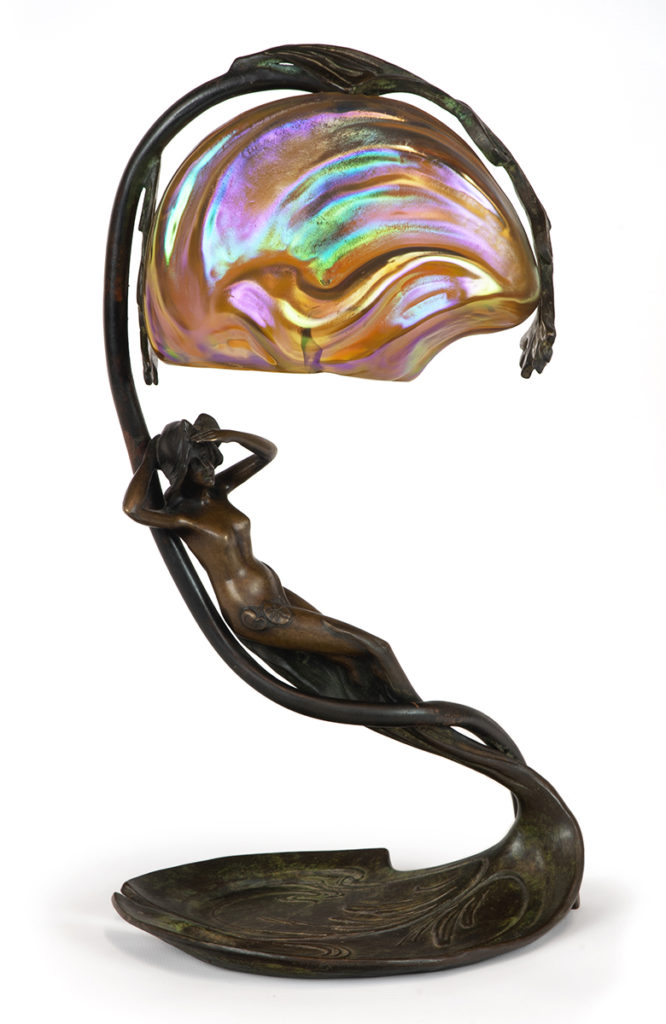
c. 1902
designed by Claude Bonnefond (French)
bronze and glass
13 3/4 x 7 1/2 x 6 inches
This piece is Art Nouveau.
On view in Art Nouveau Gallery 4.
I love this little Art Nouveau lamp. The whole effect is simple and elegant–evocative to me of water and shells in a whimsical way. The glass iridescent lampshade is a warm color tone (like the inside of a shell) and is supported by and wrapped in a curving bronze plant form. The bronze base has a greenish cast making if look more like a plant growing by or in water. There’s a lovely female figure reclining in the curving shape of the plant as if she’s actually growing in it, and her legs blend into it seamlessly. The female figure is shielding her eyes from the glow of the lamp which is a sweet detail to notice.
About Misha, Visitor Services Associate:
I enjoy being surrounded by the beauty of Kirkland Museum. It was my favorite museum in Denver (and still is) before starting to work part time here over a year and a half ago. My work is split between the Welcome Desk and the Museum Store. I have a master’s degree in Education and taught English, Art and Remedial Reading once upon a time. I’ve also worked as an IT analyst and in a library over the past years before coming to the Kirkland.
Kaitlin’s Favorite: Traccia Table with Bird’s Feet
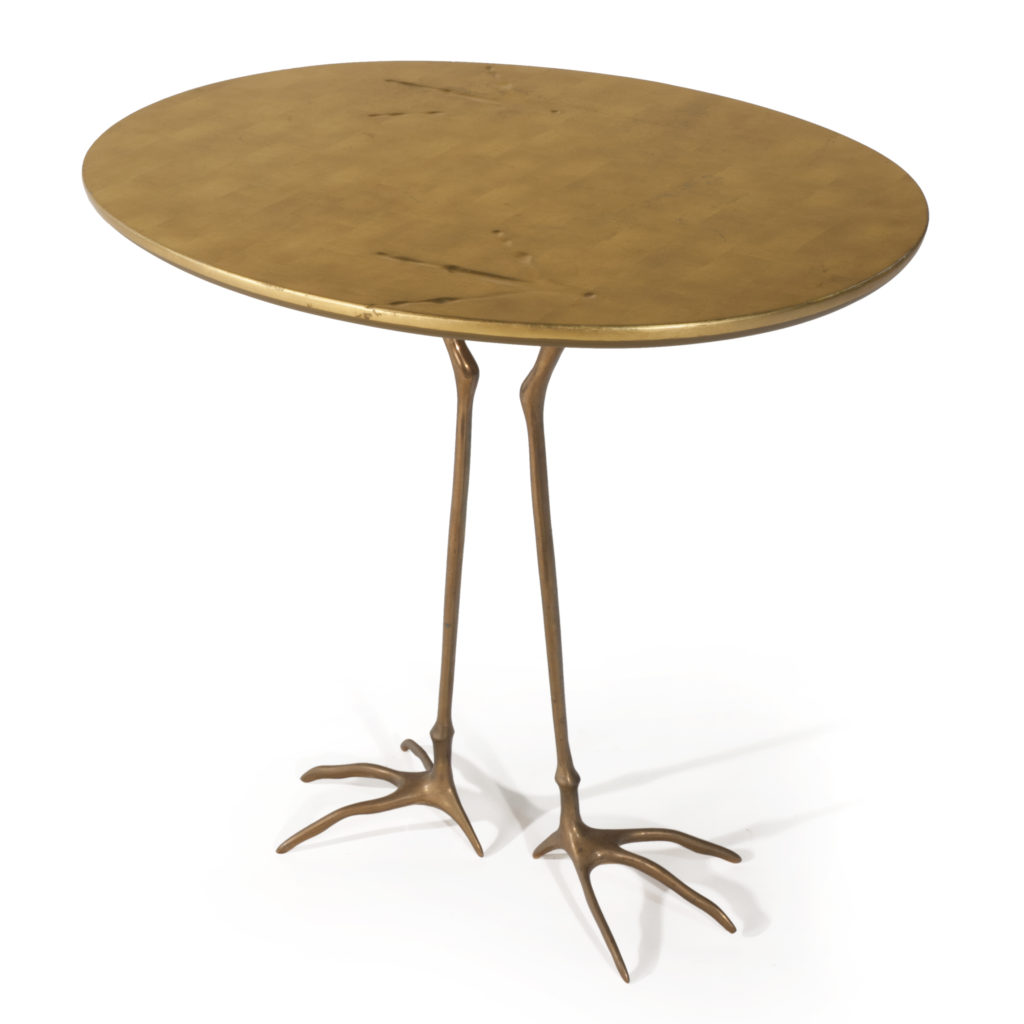
1939
designed by Meret Oppenheim (1913–1985, Swiss)
manufactured by Simon International
wood and brass
25 1/4 x 26 3/4 x 21 inches
This piece is International Style/Surreal.
On view in Bauhaus Gallery 5.
One of my favorite pieces in the Museum’s collection would have to be the Traccia Table with Bird’s Feet designed by Swiss surrealist Meret Oppenheim. Perhaps most commonly known for her fur-lined teacup and saucer, Oppenheim’s designs always push the envelope, encouraging viewers to take a second look with a good sense of humor thrown in. I learned that during her career she modeled for the artist Man Ray, and was said to have been friends with Picasso and Max Ernst. Always clever in her designs, the success of her work helped pave the way for women artists who came after her.
I love fun, eclectic pieces for the home, and this brass side table has always caught my eye as someone who loves metallics. Heavily inspired by dreams, Oppenheim worked in a myriad of mediums, but I love her designs that push Surrealism into the three-dimensional realm. This particular table has been so popular since its production that a number of retailers have even produced lower cost knock-off versions.
About Kaitlin Morelock, Membership & Office Coordinator:
I currently work as the Membership & Office Coordinator, starting as a Visitor Services Associate in 2018 after moving to Denver from my home state in Northwest Arkansas. I do work across various departments, but primarily, I oversee the day-to-day aspects of the membership program, process Museum donations and assist with research and Curatorial projects when available.
A fun fact about myself is that I’m a huge fan of all things interior design, so being able to work in a location with such an amazing collection of Decorative Art has been a great way to not only broaden my background in art history, but add more meaning to a personal hobby as well.
Renée‘s Favorite: The Lovers
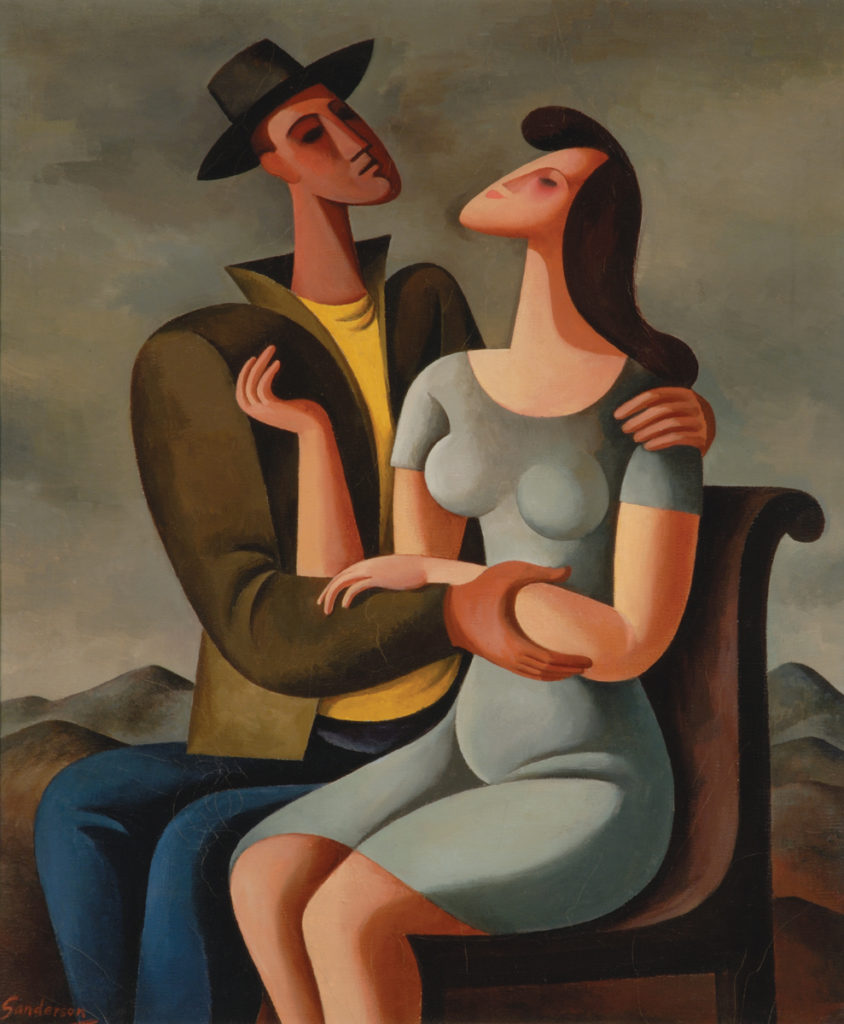
1947
by William Sanderson (1905–1990, American, b. Latvia)
oil on canvas
23 3/4 x 19 1/2 inches
This painting is Regionalism.
On view in Promenade Gallery 2.
I was immediately drawn to William Sanderson the first time I saw a collection of his work. Sanderson began his career as an illustrator for books and magazines as a commercial and freelance artist and it is that illustrative quality of his paintings that I find so charming. The Lovers is a wonderful example of the whimsical yet quietly moody nature found in many of his works. And in this current climate of challenge and stress, The Lovers is a nice reminder that joy and love can still be found all around us!
About Renée Albiston, Associate Museum Director:
I am honored to serve as Kirkland Museum’s Associate Museum Director. I have been with the Museum for nearly 10 years and last served as the Director of Curatorial Affairs before moving into my leadership role at the beginning of this year. I am continually in awe of the new discoveries found among the treasures in our robust collection and find it especially enjoyable to witness our guests’ reaction when they visit.
A little known fact about me—my undergraduate and graduate academic career focused on World War II looted art restitution issues and I moonlight as a provenance researcher and lecturer for various cultural institutions and universities.
Becca G.‘s Favorite: Atomizer
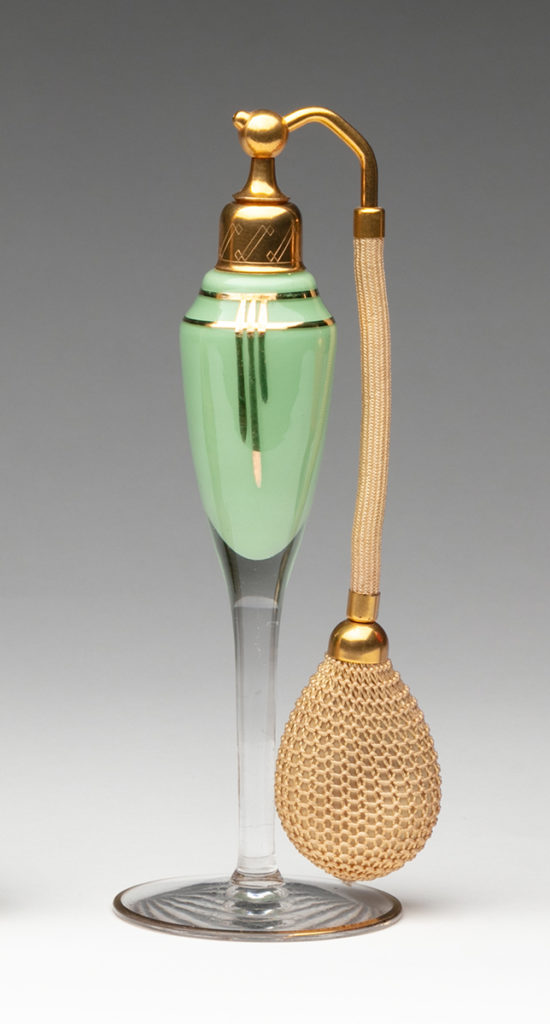
c. 1927–c. 1931
atomizer manufactured by
Devilbiss Manufacturing Co., Toledo OH (1888–present), glass bottle unknown manufacturer
metal and glass
7 x 3 x 2 1/2 inches
This piece is Art Deco.
On view in Art Deco Gallery 6.
This Deco-era perfume atomizer is one of my favorite objects in the collection. The atomizer top was manufactured by the DeVilbiss Corporation of Toledo, OH, which has a fascinating history. Dr. Allen DeVilbiss invented the first atomizer as a nose and throat spray. His son Thomas had the idea to turn this invention into perfume atomizers, which helped the company become wildly successful. The company still exists today as an automotive refinishing company, manufacturing spray guns and airbrushes.
I love these bottles because they are so feminine and beautiful as well as quite useful. I like to imagine a fashionable and rebellious flapper woman getting ready for a night out and spraying her perfume as she walks out the door to go to the coolest speakeasy in town. It’s like ZaSu Pitts in a scene from the movie They Just Had to Get Married from 1932. You can see multiple perfume bottles on her dressing table and a DeVilbiss one clutched in her hand. Because I am the Collections & Research Manager at Kirkland Museum, I have the honor and privilege of caring for and handling these objects and I can say from experience that one of the best parts of these atomizers is when opened, some of them still smell heavenly!
About Becca Goodrum, Collections & Research Manager:
I have been with Kirkland Museum for five years now, working for the Curatorial Department. I was briefly at the former location and now am lucky enough to work in this beautiful new building. I have the pleasure of caring for this incredible collection every day, which means as you can imagine, I am never bored!
A fun fact about me is I love medieval European history. I took a lot of classes on this topic in undergrad and continue to read books, listen to podcasts (check out History Extra from BBC history), and soak up whatever I can about medieval history to this day. My favorite queens are Eleanor of Aquitaine (obviously!) and Matilda (Eleanor’s mother-in-law), who was never actually queen, but she should have been. It was not an easy time to be a woman, even if you were a wealthy woman like the two of them, but they were strong, stubborn and indomitable and I love that.
Charlotte‘s Favorite: Clarice Cliff ceramics
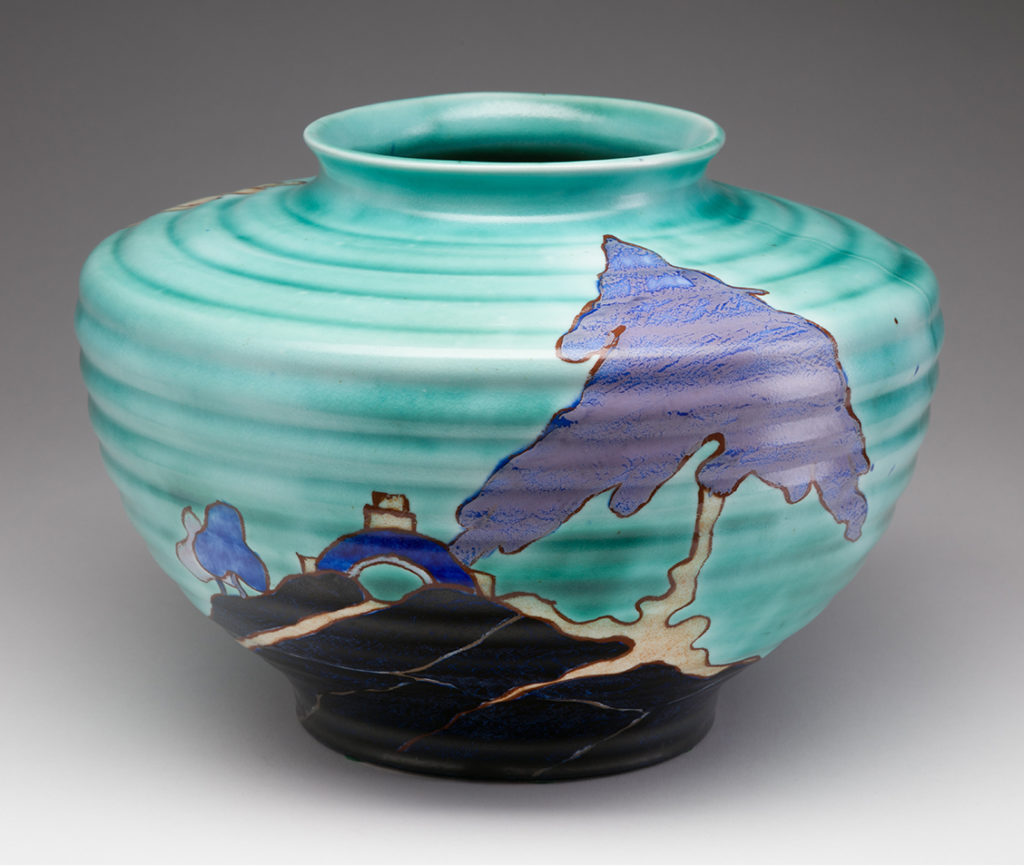
1928–1941
designed by Clarice Cliff (1899–1972, English)
manufactured by Newport Pottery
ceramic
6 3/4 x 10 inches
Gift of Gloria Zakus.
This piece is Art Deco.
On view in Art Deco Gallery 6.
The Museum has so many incredible Art Deco pieces, but the ceramics by British artist Clarice Cliff have always been some of my favorites! Cliff’s unexpected use of vibrant colors and bold forms in her Bizarre Ware line, completed from the late 1920s into the 1930s, epitomizes the creative energy I imagine flowed throughout the Art Deco period. I also admire Cliff’s personal journey, who as a young woman worked her way up at Wilkinson Pottery, subsequently navigating a hugely successful career and employing dozens of other women (called the “Bizarre Girls”) who hand painted and promoted the line alongside Cliff.
Each Bizarre Ware piece has its own unique personality, much like the women I envision painting them at the time. I simply love how the work is unabashedly playful yet so well designed—surely a worthy conversation piece at any dinner table!
About Charlotte Otto, Director of Retail & Visitor Services:
I’ve overseen the Visitor Services Department at Kirkland Museum since 2014, including daily operations, staffing, ticketing and management of the Museum Store. I love the variety in my job as well as working in such close proximity to our incredible collection on a daily basis. And I may be slightly biased, but I think we have some of the most friendly, knowledgeable volunteers and visitors a museum could ever ask for!
Fun fact: I hold a BA in Studio Art with a concentration in photography, however I have yet to ever take a ceramics class. It’s something I aspire to, especially being surrounded by such an incredible ceramics collection!
Emily’s Favorite: PH Artichoke Hanging Lamp
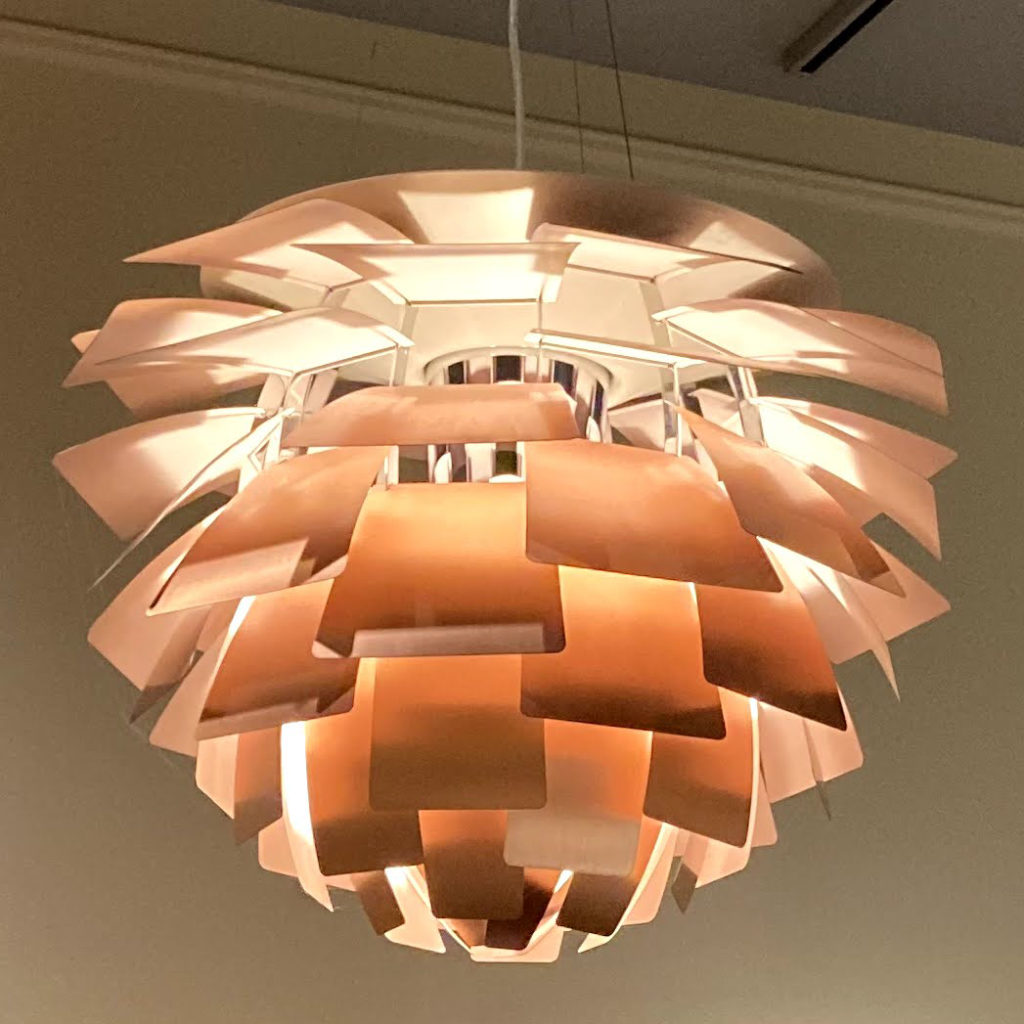
1958
designed by Poul Henningsen (1894–1967, Danish)
manufactured by Louis Poulsen
copper, steel and aluminum
27 x 36 inches
This piece is Modern.
On view in Modern Gallery 7.
I have loved learning about multiple pieces in the Kirkland collection, but one piece in particular really sticks out to me. It is the PH Artichoke Hanging Lamp which can be found hanging in the back right corner of our Modern Gallery 7. We have such a vast collection that sometimes I think patrons often forget to look up, myself included. I hadn’t noticed it until one of our wonderful volunteers, Judy, pointed out to me that the light is designed in such a way that you are unable to see the light source from any angle. Upon learning this I became fascinated by the light and its design.
With further research, I learned some great fun facts about the hanging lamp:
It was designed by Danish architect and designer Poul Henningsen, hence the PH in the name.
The light was originally designed and built in 1958 for a restaurant in the Langelinie Pavilion in Copenhagen. According to one source, years later the originals were cut from their chords and stolen during a heist. However, most of them were tracked down and returned to the restaurant.
Louis Poulsen still produces the lights. They continue to be mostly assembled by hand and in order to keep the secret of the design, there are only a few people who know how to put them together.
There are several copycat versions, but you will know immediately they are not an original because no other design is built in such a way that you can’t see the light source.
About Emily, Visitor Services Associate:
I’ve been lucky enough to work at the Kirkland Museum since June 2019 as a Visitor Services Associate. You’ll find me checking in visitors when they arrive and also working in our beautifully curated Museum Store. At the beginning of 2020 I also started to assist with Museum events. A fun fact about me is that I love music and saw over 200 bands perform live in 2019.
Bekii‘s Favorite: Stokke Armchair
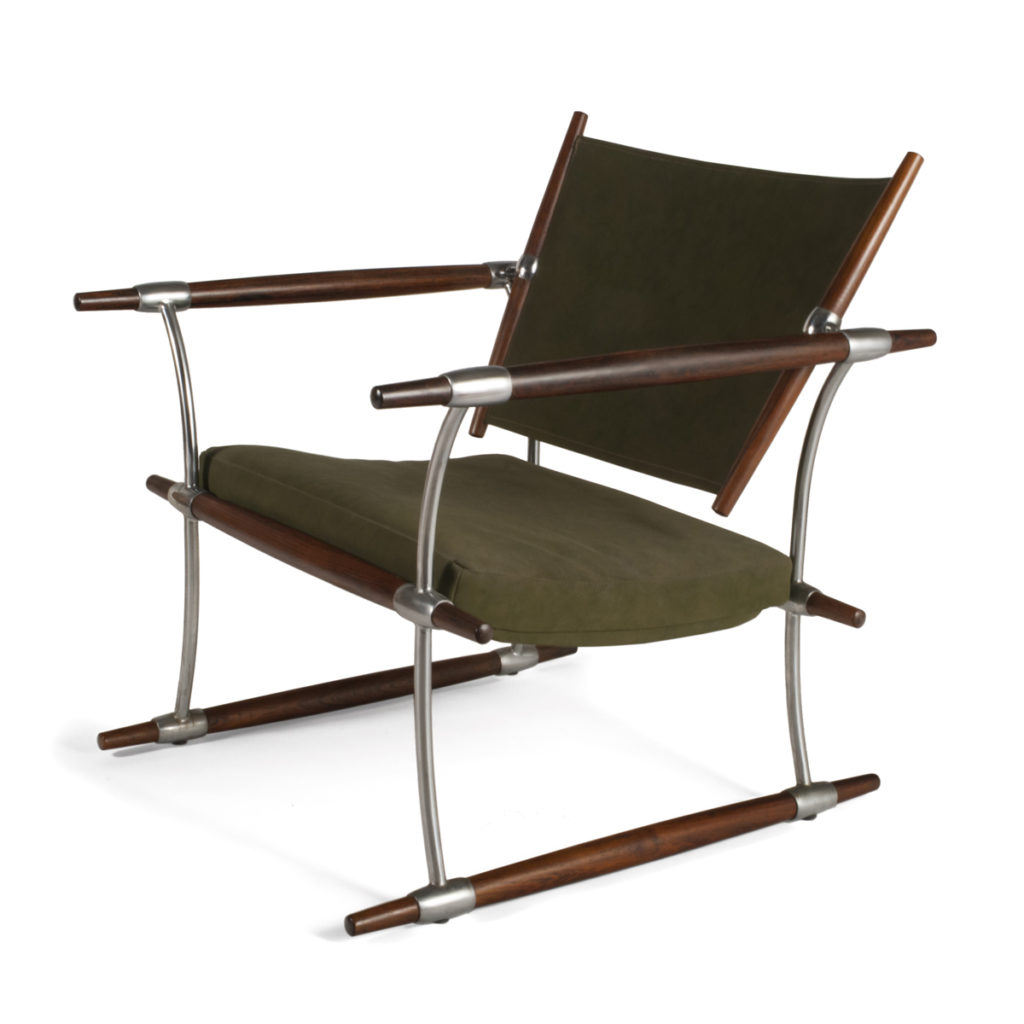
1965
designed by Jens Harald Quistgaard (1919–2008, Danish)
manufactured by Nissen Traevarefabrik (Richard Nissen)
brazilian rosewood, chrome-plated steel and upholstery
28 1/2 x 26 x 26 1/2 inches
This piece is Modern.
On view in Modern Gallery 7.
The first time I really appreciated the Stokke Armchair was about a year ago after Charlotte (Director of Retail & Visitor Services) pointed out to us that the chair had no joinery holding it together; instead Quistgaard looped together chrome bars and hooks, relying on internal tension to keep it sturdy! Ever since, I’ve kept coming back to how clever a design it is. It’s practical—lightweight and the parts are so easy to collapse and reassemble—but its materials still make it seem comfortable and stylish so it feels like it belongs in a homey space. It’s definitely a successful example of functional design!
About Bekii, Visitor Services Associate:
I’ve been with the Museum as a member of Visitor Services since its reopening in 2018. I get to help out with a lot of daily operations, and get the chance to have exciting conversations with our Museum guests about the collection! I’m really grateful to work with such a lovely team and delighted about how much I have learned.
Becca R.’s Favorite: Canyon Cloudshow
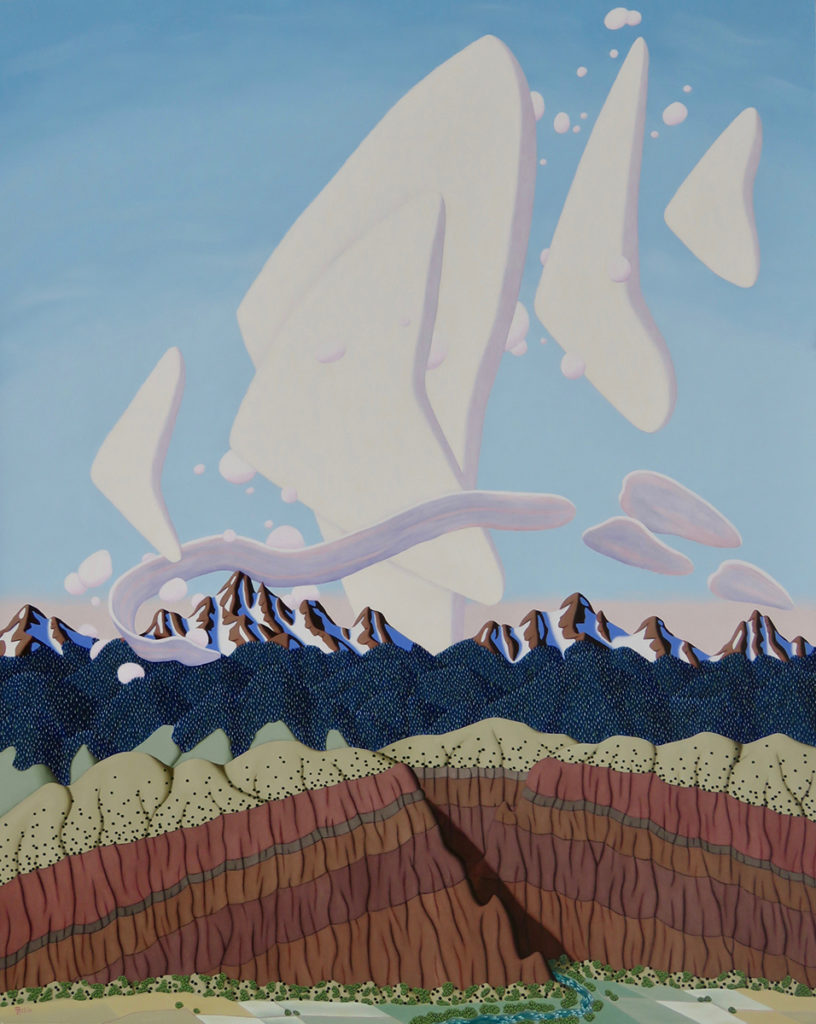
2017
by Tracy Felix (b. 1957, American)
oil on panel
60 x 48 inches
Gift of Tracy & Sushe Felix.
This piece is Referential Abstraction.
On view in Modern Gallery 7.
This painting is by my favorite local artist, Tracy Felix. He is a landscape painter, but I love how his work highlights Colorado and Southwestern skylines. Each painting is full of exaggerated cloud forms bursting with charm and personality. Some of his clouds are white and light, like marshmallows happy to be floating over a nearby mountain range. Others resemble stacked pancakes cooling amidst a calm blue sky. Sometimes, Felix’s clouds appear heavy, sitting low in the sky and threatening rain. In another painting in the Kirkland Museum’s collection, Mountain Rain, the showers resemble fingers that seem to tickle the mountain tops. His work profiles our region’s beautiful and ever-changing skylines, but with great emotion and even a bit of whimsy.
About Becca R., Visitor Services Associate:
I have worked at Kirkland Museum as a Visitor Services Associate for about two years. You can usually find me in the Museum Store. I am an avid gardener; a collector of weird and wonderful objects; and I own a lot of shoes. I love museums of all kinds and visit them everywhere I go—which is why I decided to study them. I am currently working on an MA in Museum Studies.
Sherise’s Favorite: Museum Dinnerware
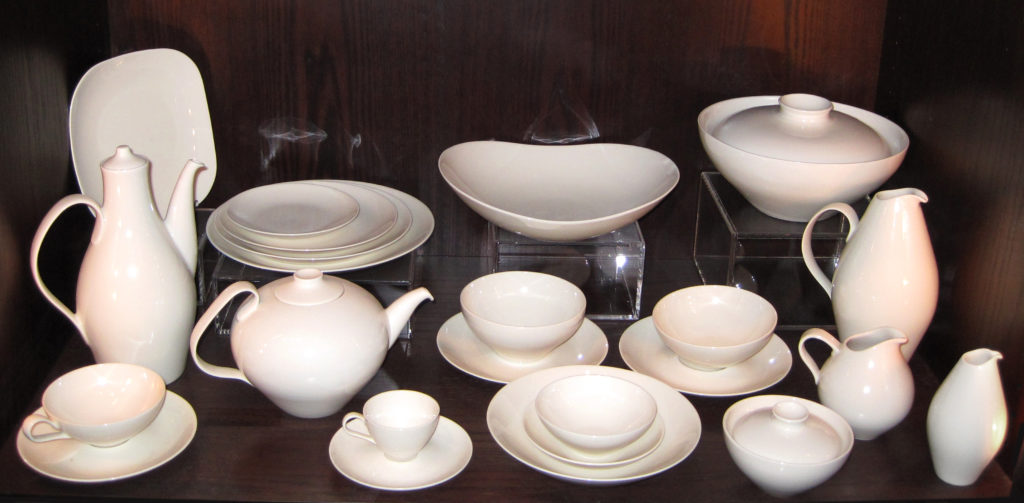
1942–1945
designed by
Eva Zeisel (1906–2011, American, b. Budapest)
manufactured by Shenango Pottery Co.,
for Castleton China Co.
porcelain
These pieces are Modern.
On view in Modern Gallery 7.
It’s hard to choose just one object when you are talking about the designs of Eva Zeisel. Many of her ceramic designs were meant to nest together to save space and create a modular design and were rarely meant to stand alone. Zeisel’s Museum Dinnerware is the ceramic line that initially captured my attention as a young ceramicist. Zeisel was commissioned in 1942 by the Museum of Modern Art and Castleton China to design a set of modern, undecorated china that would be worthy of an exhibition at MoMA. The resulting exhibition, New Shapes in Modern China Designed by Eva Zeisel, ran in 1946, and was the first one-woman exhibition at MoMA.
It was also the design of Museum Dinnerware that introduced Eva Zeisel to the American design industry. In an industry dominated by men, she established herself as a first-rate designer, straight off the boat. Her forms have always struck me as exceptional because they require no surface ornamentation. The forms themselves are simple, curvaceous and uplifting. “I wanted it to look as if it was growing up from the table,” she said of the modern and organic lines of the set.
About Sherise Talbott, Visitor Services & Volunteer Supervisor:
I’ve been working with the Museum since 2012, initially as a volunteer. In my current role as Visitor Services & Volunteer Supervisor, I help run the day-to-day operations at the Museum. I coordinate the Welcome Desk, Museum Store, security staff and volunteers to provide a pleasant visitor experience daily at the Museum.
A fun fact about myself is that I got my Fine Arts degree in Ceramics. I love to put my hands in mud and make pottery for family and friends. Learning to make forms from clay has become a lifelong obsession and adventure. I love to learn about local ceramics in Colorado, and Kirkland Museum has one of the best collections to learn from.
Maya’s Favorite: Vance Kirkland’s First Dot Painting
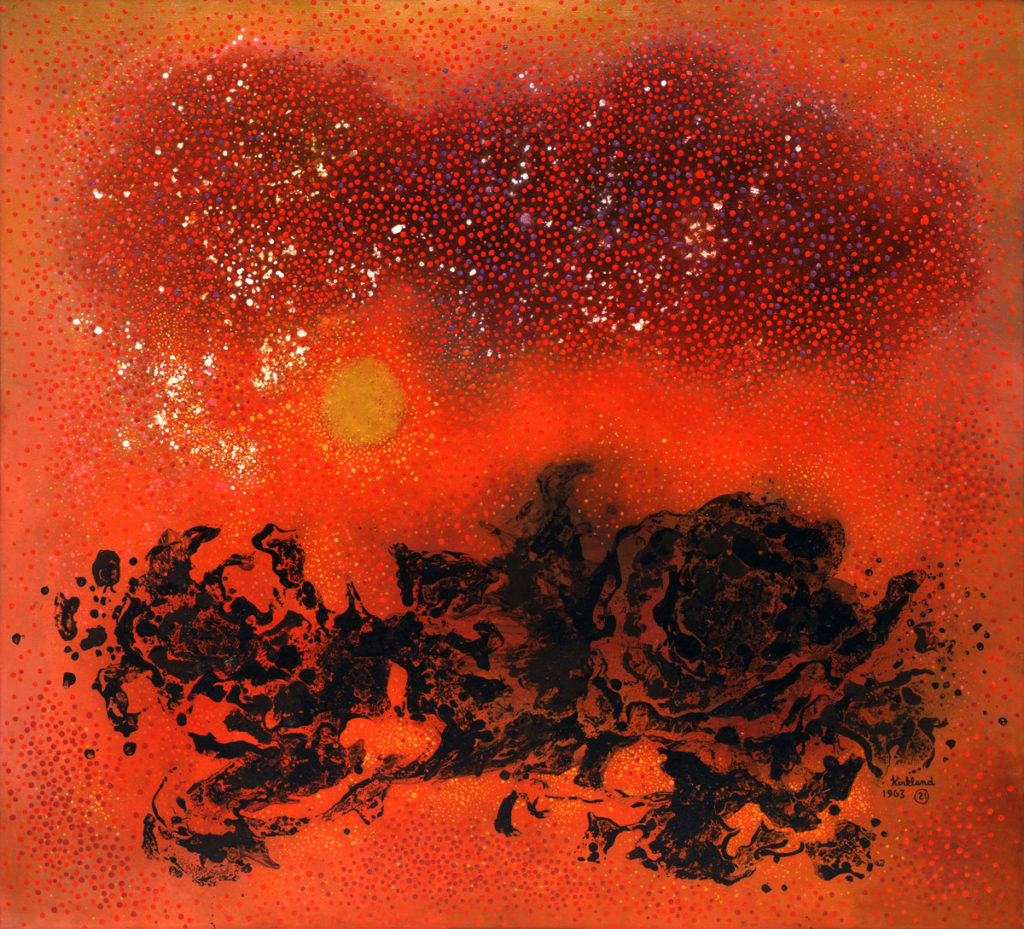
1963
by Vance Kirkland (1904–1981, American)
oil paint and water on linen
60 x 66 inches
This piece is from Vance Kirkland's Dot Painting period.
On view in Colorado Ceramics Corridor 17, just outside the Video Room.
I have fallen in love with Vance Kirkland’s paintings and story in my 15 years working at Kirkland Museum. His work continues to surprise me. I’m fascinated with the transitions in his career—from being an accomplished watercolorist and surrealist, to embracing pure abstraction and inventing new techniques.
This is Kirkland’s first dot painting, the 21st painting he finished in 1963 and the first step in transitioning to his last and best-known painting period. You can see the idea is new. He does not cover the black oil paint and water technique with dots yet, and the dots are far from the perfect circles he achieved later with dowels. He was using sticks and paintbrushes to create texture. I love to see how his ideas and techniques evolved, and this painting shows how the idea of dots first worked for him.
Kirkland intentionally named the painting without suggesting a reference, but I see a sunset over the sea—the gold circle hanging above the black waves. The color is bold and the dots vibrate with contagious energy.
About Maya Wright, Director of Interpretation:
I am a Denver native and have been lucky to have been on the Kirkland team in a multitude of roles since 2005. I have an MA in Art History and Museum Studies from the University of Denver. As the Director of Interpretation, I work on Kirkland Museum communications, programming, exhibition planning, the website and other ways we share information about the Museum and collection. Fun fact: I was a theatre major at Denver School of the Arts for middle and high school and still enjoy public speaking and giving tours.
If you enjoyed this virtual exhibition, take a moment to see others at the link below:
